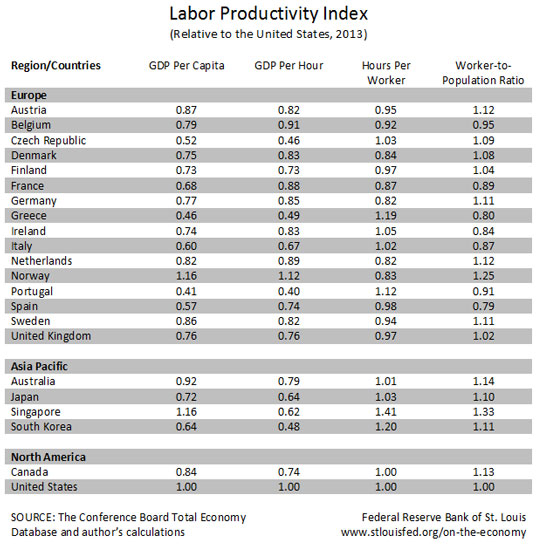How Should Labor Productivity Be Measured?
Gross domestic product (GDP) per capita is often used as the barometer when comparing labor productivity and the standard of living across countries. A recent Economic Synopses essay by Ana Maria Santacreu, an economist with the Federal Reserve Bank of St. Louis, posited that GDP per hour worked might be a better measure of labor productivity.
Santacreu noted that GDP per hour worked captures technology, which is the main driver behind differences in productivity. Also, GDP per capita can be influenced by other variables such as fertility and mortality rates, the number of hours worked, and the composition of the labor force. These differences can cause the two GDP measures to differ widely within a given country and relative to the U.S. Santacreu broke down GDP per capita as follows:

Regarding the right side of the equation, the three components represent, respectively:
- Amount of output produced per hour worked
- Average number of hours worked per worker (a measure of effort)
- The worker-to-population ratio, which depends on labor force participation and employment rates
The table below shows this breakdown for selected countries.

The data show that there are noticeable differences between GDP per capita and GDP per hour worked, relative to the U.S. For instance, Belgium, France, Germany and Spain were closer to the U.S. in GDP per hour worked than in GDP per capita. Santacreu noted, “This finding suggests that labor utilization in these countries is much lower than in the United States.”
Among Asian countries, several were either close to or had surpassed the U.S. in GDP per capita, but were further behind in GDP per hour worked. As Santacreu pointed out, this was largely due to Asians working longer hours. She also noted, “Going forward, the disparity may lessen as working hours in Asian countries are declining.”
Santacreu concluded, “While GDP per capita is widely used to compare labor productivity across countries, GDP per hour may be a more accurate measure.”
Additional Resources
- Economic Synopses: Measuring Labor Productivity: Technology and the Labor Supply
- On the Economy: What Size Firm Has Created the Most Jobs in the Recovery?
- On the Economy: Are Wages and the Unemployment Rate Correlated?
Citation
ldquoHow Should Labor Productivity Be Measured?,rdquo St. Louis Fed On the Economy, March 3, 2015.
This blog offers commentary, analysis and data from our economists and experts. Views expressed are not necessarily those of the St. Louis Fed or Federal Reserve System.
Email Us
All other blog-related questions

